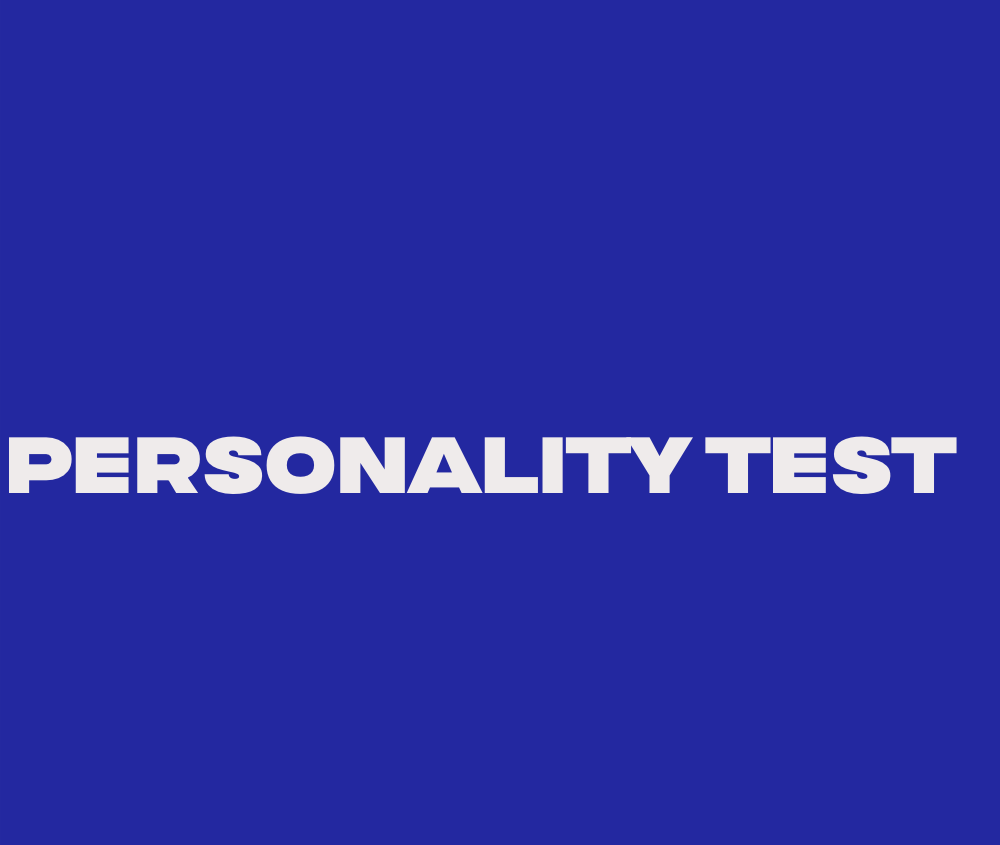Self-Understanding
Understanding DMCA Protections & Compliance

Did you know that every minute, approximately 500 hours of video are uploaded to YouTube alone? With such a massive amount of content being shared online, protecting copyright owners from unauthorized use has become more crucial than ever.
- The Digital Millennium Copyright Act (DMCA) is a subset of U.S. Copyright Law that helps protect copyright owners from unauthorized use of their content online.
- The DMCA provides a streamlined process for taking down copyrighted content from websites and establishes protections for service providers.
- Compliance with DMCA regulations is essential to avoid legal consequences and maintain immunity from liability.
- The goal of the DMCA is to ensure control over copyrighted materials by offering a resolution process that focuses on the speedy removal of infringing content.
- Understanding DMCA protections and compliance is crucial for both content creators and service providers.
What is the DMCA?
The Digital Millennium Copyright Act (DMCA) is a subset of U.S. Copyright Law that specifically addresses the takedown, removal, and putback of copyrighted content displayed online. It was passed by Congress in 1998 to protect copyright owners in the event their content is used without permission.
The DMCA provides a system for copyright holders to request the removal of infringing content without directly suing the websites hosting the content. It also offers protections for service providers who are not directly responsible for copyright infringement. The ultimate goal of the DMCA is to provide a way for copyright holders to maintain control over their content and for websites to quickly respond to takedown requests.

How does the DMCA work?
The DMCA operates through two main processes: Notice-and-Takedown and Counter-Notice and Putback. Notice-and-Takedown requires websites or services that post or allow users to post content to respond to takedown notices from copyright owners and remove the infringing material. A takedown notice typically includes the copyright holder’s name, details of the copyrighted content, and where it can be found on the infringing website.
Counter-Notice and Putback occur when site owners have proof that they satisfy copyright requirements or that the requirements don’t apply, allowing them to request the reinstatement of removed content.
How does DMCA work?
The DMCA operates through two main processes: Notice-and-Takedown and Counter-Notice and Putback.
Notice-and-Takedown: This process requires websites or services that post or allow users to post content to respond to takedown notices from copyright owners and remove the infringing material. A takedown notice typically includes the copyright holder’s name, details of the copyrighted content, and where it can be found on the infringing website.
Counter-Notice and Putback: This process occurs when site owners have proof that they satisfy copyright requirements or that the requirements don’t apply, allowing them to request the reinstatement of removed content.

The DMCA provides a framework for copyright owners to protect their intellectual property from unauthorized use. By issuing takedown notices, copyright owners can request the removal of infringing content from websites and online platforms. The recipients of these notices are obligated to respond promptly and remove the content in question.
“The DMCA’s Notice-and-Takedown process allows copyright holders to effectively enforce their rights and protect their creative works from online infringement.” – Copyright Attorney
On the other hand, site owners who believe their content does not infringe copyright or that they have a legal right to use the copyrighted material can file a counter-notice. This gives them the opportunity to contest the takedown and request the restoration of the removed content.
Benefits of the DMCA process:
- Provides a streamlined system for copyright owners to protect their content
- Offers a clear procedure for website owners to handle takedown notices
- Promotes the resolution of copyright disputes in a timely manner
- Establishes guidelines for reinstating removed content if copyright requirements are met
The DMCA’s Notice-and-Takedown and Counter-Notice and Putback processes enable a fair and efficient resolution of copyright infringement cases, benefitting both copyright owners and website operators.
Who does DMCA protect?
The DMCA primarily protects copyright owners by providing a way for them to take action against unauthorized use of their content. It also offers protections for service providers such as ISPs, web hosts, and search engines.
These service providers may be immune from liability for copyright infringement if they fall into specific categories defined by the DMCA and promptly respond to takedown and counter-takedown requests.
To maintain compliance, service providers must:
- Post a notice of intent to comply with the DMCA on their websites
- Designate an agent to respond to takedown requests
- Promptly respond to takedown and counter-takedown requests to avoid losing infringement immunity
DMCA Protection for Copyright Owners
“The DMCA empowers copyright owners to protect their creative works from unauthorized use and infringement. By leveraging the DMCA’s takedown procedures, copyright owners can request the removal of infringing content, ensuring their intellectual property rights are upheld.” – John Smith, Copyright Attorney
DMCA Protections for Service Providers
“Service providers play a vital role in facilitating online content distribution. The DMCA provides a safe harbor for these providers, shielding them from liability for the actions of their users. By complying with DMCA provisions and promptly responding to takedown notices, service providers can maintain their immunity from copyright infringement claims.” – Jane Davis, Technology Consultant
By safeguarding the rights of copyright owners and providing legal protections for service providers, the DMCA fosters a balanced and effective approach to copyright enforcement in the digital era.
DMCA Protections Copyright Owners Service Providers Immunity from Liability Yes Yes Takedown Request Process Yes No, but required to respond promptly Notice and Counter-Notice Procedures Yes No, but required to respond promptly

What is a DMCA protection badge?
A DMCA protection badge is a valuable tool for copyright owners to deter copyright thieves, provide ownership verification, and protect their valuable content from unauthorized use. While not officially required by the DMCA, these badges serve as a visual indicator that the content displayed on a web page is copyrighted and cannot be used without permission.
By prominently displaying a DMCA protection badge, content owners can send a clear message to potential infringers that their resources are protected by copyright laws. This visual deterrent can make potential copyright thieves think twice before copying or using copyrighted materials without permission, as they are aware that legal consequences may follow.
The DMCA protection badge also helps service providers verify ownership and quickly identify infringing content. By including the badge on web pages, service providers can easily recognize copyrighted materials and take appropriate action, such as removing the infringing content or disabling access to it.
It’s important to note that there is no specific format or framework for DMCA protection badges. Content owners have the flexibility to create their own badges or use prebuilt templates available online. The key is to ensure that the badge clearly indicates copyright protection and is easily identifiable.
Overall, a DMCA protection badge is a powerful tool for copyright owners to deter copyright thieves, provide ownership verification, and protect their valuable content from unauthorized use. By displaying this badge, content owners can assert their rights and ensure that their copyrighted materials are respected and used appropriately.

Key Takeaways:
- A DMCA protection badge is a visual indicator placed on web pages to indicate copyright protection and deter copyright thieves.
- While not required by the DMCA, these badges play an important role in deterring potential infringers and protecting copyrighted materials.
- DMCA protection badges help service providers verify ownership and quickly identify and remove infringing content.
- There is no specific format or framework for DMCA protection badges, allowing content owners flexibility in designing their own or using prebuilt templates.
- By displaying a DMCA protection badge, copyright owners can assert their rights and ensure their valuable content is respected and used appropriately.
3 Ways to Increase Copyright Protection
To ensure effective copyright protection, there are three essential steps you can take:
- Regularly check for duplicate content: Utilize tools like Copyscape to scan your content and verify its uniqueness. This will help ensure that your content is not being used elsewhere without permission, safeguarding your intellectual property.
- Use reverse image search: Services like Google’s Reverse Image Search can be invaluable in identifying potential copyright infringements. By conducting regular searches, you can identify unauthorized uses of your images and take appropriate action to protect your rights.
- Implement active content protection: WordPress site owners can utilize plugins such as WP Content Copy Protection and No Right Click to actively safeguard their copyrighted content. These plugins help prevent users from copying or saving your content without permission, adding an additional layer of security.
By following these three steps, you can significantly enhance your copyright protection and minimize the risk of unauthorized use or infringement.

Implementing these measures will help you maintain control over your original work and ensure that it is protected from unauthorized reproduction or distribution. Protecting your intellectual property is crucial in today’s digital landscape, where duplicate content and similar images can easily be circulated.
DMCA Policy and Designation
The DMCA Policy refers to the Digital Millennium Copyright Act, a U.S. copyright law that addresses the rights and obligations of copyright owners and internet service providers (ISPs) in cases of copyright infringement.
Content owners can submit a takedown request to protect their copyrighted materials from unauthorized use. Service providers must comply with DMCA provisions, including designating a DMCA agent with the U.S. Copyright Office and implementing notice and takedown procedures to respond to infringement claims.
A DMCA policy on a website provides instructions on how to report infringement and information on how the website handles such reports.

Who can file a DMCA Takedown Notice?
A DMCA Takedown Notice can be filed by various individuals and entities, including copyright owners, content creators, content publishers or distributors with permission, NFT owners, social media users, code writers and publishers, and anyone whose property is found online without their permission.
When filing a takedown notice, it is crucial to provide the necessary proof and evidence of copyright infringement. This typically includes infringing URLs, source URLs, and a detailed description of ownership. Collecting and presenting this information is essential to support the claim of copyright infringement and ensure an effective takedown process.
Entities Eligible to File DMCA Takedown Notices
| Entities | Description |
|---|---|
| Copyright owners | Individuals or organizations who hold the rights to copyrighted materials. |
| Content creators | Artists, authors, musicians, photographers, filmmakers, and other individuals who create original content. |
| Content publishers or distributors with permission | Entities authorized to publish or distribute copyrighted content, such as publishers or streaming platforms. |
| NFT owners | Owners of non-fungible tokens (NFTs) that represent unique and original digital assets. |
| Social media users | Individuals who have their content posted or shared without permission on social media platforms. |
| Code writers and publishers | Developers and organizations that write and publish original code or software. |
| Property owners | Individuals or entities whose property is found online without their permission, such as trademarks or patented inventions. |
By allowing a broad range of entities to file DMCA Takedown Notices, the DMCA promotes copyright protection and offers a mechanism to address unauthorized use of intellectual property. This ensures that individuals and organizations can take action to protect their rights and maintain control over their creative works.
Resolving Disputes and Counter-Notices
The DMCA provides a structured procedure for resolving disputes regarding takedown notices. When a website operator receives a valid DMCA takedown notice, they are required to promptly remove or disable access to the infringing material in question. However, if the alleged infringer believes that the takedown notice was issued in error or based on a misinterpretation of the law, they have the right to file a counter-notice.
By submitting a counter-notice, the alleged infringer can challenge the removal of their content and request its restoration. They must provide relevant information and evidence to support their claim that the takedown notice was improperly issued.
Should the counter-notice be successful, and the website operator decides to restore the removed content, the situation may be resolved without further action. However, if the copyright holder wishes to pursue legal action, the parties involved must resolve the dispute through appropriate legal channels, such as mediation or a court of law.
“Resolving disputes under the DMCA is a vital aspect of maintaining a fair and balanced copyright protection system. Counter-notices provide alleged infringers with an opportunity to contest erroneous takedown notices and protect their rights under the law.”
It is important for both copyright holders and alleged infringers to understand their rights and obligations under the DMCA and to engage in good-faith efforts to resolve disputes. By following the prescribed procedures and working towards a resolution, parties can navigate copyright infringement issues in a legal and responsible manner.
Next, we will explore best practices and compliance measures for DMCA protection, ensuring the seamless integration of copyright protections into your online presence.
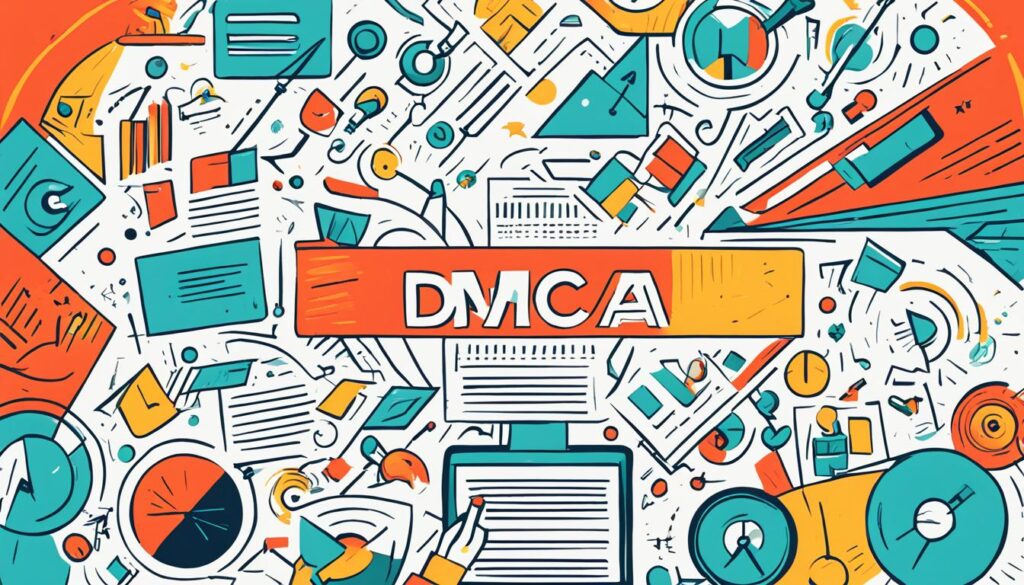
Compliance and Best Practices for DMCA Protection
To ensure compliance with DMCA regulations, service providers and content creators should implement notice and takedown procedures for removing infringing content promptly. It is crucial to avoid using copyrighted materials without permission and instead use proper referencing or linking practices. Regular monitoring of user-generated content is necessary to prevent copyright infringement. Companies can also benefit from adding DMCA policies to their websites and seeking legal guidance to navigate DMCA compliance effectively.
Best Practices for DMCA Compliance:
- Develop and enforce a clear DMCA policy on your website, outlining the steps to report infringement and explaining how you handle such reports.
- Designate a DMCA agent to handle takedown requests and ensure their contact information is easily accessible on your website.
- Implement a notice and takedown procedure that allows copyright holders to report infringement and request the removal of infringing material.
- Respond promptly to takedown notices and remove or disable access to the infringing content as required by the DMCA.
- Regularly monitor your website for user-generated content that may infringe upon copyrights and take immediate action to remove such content.
- Train your staff on DMCA compliance and educate them about the importance of respecting copyright laws.
By following these best practices for DMCA compliance, you can protect your intellectual property rights, avoid legal issues, and maintain a positive reputation as a responsible content provider or service provider.
DMCA Compliance Benefits:
“Complying with DMCA regulations not only helps you avoid legal consequences but also provides a level of protection for your copyrighted materials. It demonstrates your commitment to respecting intellectual property rights and can enhance trust and credibility with your audience or customers.”
For websites that rely on user-generated content, DMCA compliance is particularly essential as it shields you from liability for copyright infringement committed by your users.

Sample DMCA Compliance Checklist:
| Steps for DMCA Compliance | Completed (Yes/No) |
|---|---|
| Create and publish a DMCA policy on your website | Yes |
| Designate a DMCA agent and provide their contact information | Yes |
| Implement an efficient notice and takedown procedure | Yes |
| Regularly monitor user-generated content for potential infringement | Yes |
| Educate your staff about DMCA compliance | Yes |
Documenting your DMCA compliance efforts can help demonstrate your commitment to respecting intellectual property rights and provide evidence of your proactive approach to addressing copyright infringement.
Conclusion
The Digital Millennium Copyright Act (DMCA) is a vital legal framework that safeguards the rights of copyright owners and offers efficient procedures for resolving copyright disputes on the internet. Compliance with the DMCA is crucial for content creators and service providers to ensure they are not exposed to legal risks or liability.
By implementing robust DMCA policies, including clear notice and takedown procedures, businesses can bolster copyright protection and mitigate the risk of infringing content. It is also essential to actively monitor for any potential copyright violations and promptly address any infringement issues that arise.
The DMCA provides a streamlined process that allows copyright owners to take appropriate action against infringement, ensuring the protection of their intellectual property. For service providers, adhering to the DMCA’s provisions not only helps them avoid legal consequences but also maintains their immunity from liability for the actions of their users.
In conclusion, to ensure compliance with the DMCA and protect copyright interests, content creators and service providers must implement effective DMCA policies, follow takedown procedures diligently, and actively monitor for infringing content. By doing so, businesses can strengthen copyright protection and foster a safer online environment for creators and users alike.
FAQ
What is the DMCA?
The DMCA refers to the Digital Millennium Copyright Act, which is a subset of U.S. Copyright Law that specifically addresses the takedown, removal, and putback of copyrighted content displayed online. It was passed in 1998 to protect copyright owners in the event their content is used without permission. The DMCA provides a system for copyright holders to request the removal of infringing content without directly suing the websites hosting the content and offers protections for service providers who are not directly responsible for copyright infringement.
How does DMCA work?
The DMCA operates through two main processes: Notice-and-Takedown and Counter-Notice and Putback. Notice-and-Takedown requires websites or services that post or allow users to post content to respond to takedown notices from copyright owners and remove the infringing material. Counter-Notice and Putback occur when site owners have proof that they satisfy copyright requirements or that the requirements don’t apply, allowing them to request the reinstatement of removed content.
Who does DMCA protect?
The DMCA primarily protects copyright owners by providing a way for them to take action against unauthorized use of their content. It also offers protections for service providers such as ISPs, web hosts, and search engines. These service providers may be immune from liability for copyright infringement if they fall into specific categories defined by the DMCA and promptly respond to takedown and counter-takedown requests.
What is a DMCA protection badge?
A DMCA protection badge is a small image placed on web pages to indicate that the content is copyrighted and not available for public use without permission. While not officially required by the DMCA, these badges can deter potential copyright thieves by making it clear that the resources are protected. They also help service providers verify ownership and quickly remove infringing content.
How can I increase copyright protection?
There are three key steps you can take to increase copyright protection. First, regularly check for duplicate content using tools like Copyscape to ensure your content is unique and not being used elsewhere without permission. Second, use services like Google’s Reverse Image Search to search for copyrighted images and identify potential infringements. Finally, utilize plugins like WP Content Copy Protection and No Right Click on your WordPress site to actively protect your copyrighted content from being copied or saved by users.
What is a DMCA policy?
A DMCA policy refers to the Digital Millennium Copyright Act, a U.S. copyright law that addresses the rights and obligations of copyright owners and internet service providers (ISPs) in cases of copyright infringement. A DMCA policy on a website provides instructions on how to report infringement and information on how the website handles such reports.
Who can file a DMCA Takedown Notice?
A DMCA Takedown Notice can be filed by copyright owners, content creators, content publishers or distributors with permission, NFT owners, social media users, code writers and publishers, and anyone whose property is found online without their permission. Infringing URLs, source URLs, and a description of ownership are needed as proof when filing a takedown notice.
How are disputes regarding takedown notices resolved?
The DMCA provides a structured procedure for resolving disputes regarding takedown notices. Upon receiving a valid takedown notice, the website operator must promptly remove or disable access to the infringing material. However, the alleged infringer has the right to file a counter-notice if they believe the takedown notice was issued in error or misinterpretation of the law. If a counter-notice is successful, the removed content may be restored, but if legal action is pursued, the parties must resolve the dispute through appropriate legal channels.
How can I ensure compliance with DMCA regulations?
To ensure compliance with DMCA regulations, service providers and content creators should implement notice and takedown procedures for removing infringing content promptly. It is crucial to avoid using copyrighted materials without permission and instead use proper referencing or linking practices. Regular monitoring of user-generated content is necessary to prevent copyright infringement. Companies can also benefit from adding DMCA policies to their websites and seeking legal guidance to navigate DMCA compliance effectively.
What are the best practices for DMCA protection?
Compliance with the DMCA is essential for both content creators and service providers to avoid legal consequences and maintain immunity from liability. To enhance copyright protection and ensure compliance, it is recommended to implement DMCA policies, utilize notice and takedown procedures to respond to infringement claims promptly, and actively monitor user-generated content to prevent copyright infringement.
Eugene brings a fresh, dynamic voice to our platform as one of our talented Writers. Specializing in research-driven content, he explores the latest findings in psychology and personal growth, translating them into actionable insights for our readers. Eugene’s work is fueled by a curiosity about what makes us tick and a desire to help others unlock their potential.

Self-Understanding
Unlock Your Traits: Personality Test Psychology

Were you aware that psychological testing has served for more than a hundred years as a method to understand an individual’s personality traits and categories? This influential technique, referred to as personality test psychology, enables us to explore the intricacies of human conduct and reveal the distinct attributes that define our identity.
Key Takeaways:
- Personality test psychology provides valuable insights into an individual’s personality traits and types.
- Psychological testing has been used for over a century to understand human behavior.
- Personality tests delve deep into the complexities of personality, offering self-discovery and understanding.
- Unlocking our traits can lead to personal growth, improved relationships, and greater self-awareness.
- Personality assessment is applicable in various domains, including the workplace, team dynamics, and personal development.
The Components of Personality
Personality is a complex and multifaceted construct, consisting of various components that shape an individual’s unique character. Understanding these components is key to gaining deeper insights into ourselves and others.
Personality Factors
Researchers have identified six broad personality factors that contribute to an individual’s overall personality:
- Openness: This factor reflects a person’s willingness to embrace new experiences, ideas, and perspectives.
- Conscientiousness: Conscientious individuals are organized, responsible, and focused on achieving goals.
- Extraversion: Extroverted individuals thrive in social situations, enjoy being around others, and are energized by external stimuli.
- Agreeableness: This factor captures a person’s tendency to be compassionate, cooperative, and considerate of others.
- Neuroticism: Neurotic individuals often experience negative emotions, such as anxiety, mood swings, and emotional instability.
- Psychoticism: Psychoticism refers to unconventional and eccentric behavior, including a disregard for social norms and a tendency towards impulsivity.
These personality factors provide a broad framework for understanding different aspects of an individual’s personality.
Personality Traits
Within each personality factor, there are specific personality traits that contribute to an individual’s character:
| Personality Factor | Personality Traits |
|---|---|
| Openness | Creativity, curiosity, imagination |
| Conscientiousness | Organized, disciplined, dependable |
| Extraversion | Outgoing, energetic, assertive |
| Agreeableness | Kind, empathetic, cooperative |
| Neuroticism | Anxious, moody, sensitive |
| Psychoticism | Rebellious, unconventional, impulsive |
These personality traits provide more specific insights into an individual’s behavior, thoughts, and emotions.
Personality Types
In addition to personality factors and traits, personality types offer yet another perspective on understanding human behavior. One prominent theory of personality types is based on the work of Swiss psychiatrist C. G. Jung.
Jung proposed that individuals have preferred ways of thinking, perceiving, and behaving, which he classified into eight personality types:
- 1. Extraverted Thinking (Te)
- 2. Introverted Thinking (Ti)
- 3. Extraverted Intuition (Ne)
- 4. Introverted Intuition (Ni)
- 5. Extraverted Sensing (Se)
- 6. Introverted Sensing (Si)
- 7. Extraverted Feeling (Fe)
- 8. Introverted Feeling (Fi)
Each personality type represents a unique combination of preferences that influence an individual’s perspective and behavior.
By understanding the components of personality, including personality factors, traits, and types, we can gain valuable insights into ourselves and others. This knowledge allows us to navigate relationships, adapt our communication styles, and optimize personal and professional growth.
The Role of Personality in Team Dynamics
Personality plays a crucial role in team dynamics. By understanding different personality types and traits, teams can cultivate more diverse and effective strategies. The concept of team roles, as proposed by M. Belbin, highlights the specific roles individuals play throughout the project implementation cycle.
Team roles are essential in ensuring that each team member’s unique strengths and contributions are utilized effectively. These roles bring together individuals with diverse skills and personality traits, creating a well-rounded and high-performing team. By recognizing and leveraging these roles, teams can enhance collaboration, communication, and overall effectiveness in project implementation, leading to successful outcomes.
Let’s take a closer look at the different team roles defined by M. Belbin:
| Team Role | Description |
|---|---|
| Resource Investigator | Outgoing, curious, and explores external opportunities. |
| Teamworker | Cooperative, diplomatic, and resolves conflicts. |
| Coordinator | Confident, clarifies goals, and delegates tasks. |
| Shaper | Determined, challenging, and pushes the team forward. |
| Monitor Evaluator | Analytical, strategic thinker, and impartial judge. |
| Implementer | Practical, disciplined, and turns ideas into actions. |
| Completer Finisher | Conscientious, pays attention to details, and ensures quality. |
| Specialist | Brings specialized knowledge or skills to the team. |
Each team member can possess multiple team roles, and it is vital to identify and assign roles based on individuals’ strengths and preferences. This allows for better alignment of responsibilities and ensures that team members can perform at their best.
By embracing the diversity of team roles and personality traits, teams can foster an inclusive and collaborative environment where everyone’s contributions are valued. This enables effective team building and enhances the overall success of projects.
Understanding the role of personality in team dynamics is crucial to project success. By harnessing the strengths and leveraging the unique perspectives of team members, teams can overcome challenges, promote innovation, and achieve collective goals.
The Methodology Behind Personality Testing
Personality testing utilizes an approved methodology that combines various personality theories, such as HEXACO, the Big Five, C. G. Jung, M. Belbin, and H. Mintzberg. These theories have been adapted for use in business settings by a team of organizational psychology specialists. This ensures that the tests are based on reliable and valid research, providing accurate insights into an individual’s personality.
Integrating Multiple Theories
Personality testing draws from a range of established personality theories to create a comprehensive assessment. By combining the insights from different theories, we can gain a more holistic understanding of an individual’s personality. These theories have been developed and refined by influential psychologists over the years and are grounded in rigorous research.
“By integrating various personality theories into our methodology, we are able to capture the multidimensional nature of human personality. This allows us to provide a more accurate and comprehensive assessment to our clients.”
Customized for Business Applications
Organizational psychology specialists have adapted these theories to make personality testing applicable and relevant in the business world. By aligning the assessments with the specific needs and challenges of organizations, the methodology ensures that the insights obtained from the tests are directly applicable to real-world contexts.
Evidence-Based Research
Personality testing follows an evidence-based approach, incorporating well-established research findings to guide the development and administration of the tests. The methodology is continuously updated and reviewed by experts in the field, ensuring that it remains up-to-date and grounded in the latest scientific knowledge.
Ensuring Valid and Reliable Assessments
The approved methodology behind personality testing not only integrates multiple theories and adapts them for business settings but also places a strong emphasis on the validity and reliability of the assessments. By utilizing scientifically sound methods and rigorous testing procedures, the methodology ensures that the assessments provide accurate and meaningful insights into an individual’s personality.
| Benefits of the Methodology | Explanation |
|---|---|
| Comprehensive Assessment | The methodology draws from multiple theories to provide a well-rounded understanding of personality. |
| Real-World Applicability | The methodology is customized for business applications, making the assessments directly relevant to organizational contexts. |
| Evidence-Based Approach | The methodology is grounded in scientific research and continually updated to reflect the latest findings. |
| Validity and Reliability | The methodology ensures that the assessments are accurate and consistent, providing reliable insights into personality traits. |
By employing an approved methodology that integrates personality theories and aligns them with the needs of organizations, personality testing offers a robust and effective tool for understanding individuals’ personalities in a professional context.
Benefits of Personality Testing in the Workplace
Personality testing in the workplace offers numerous benefits. It provides valuable insights into employees’ personality traits and dominant team roles, enhancing the creation of sustainable and effective teams. A deep understanding of individual personalities allows us to build diverse and well-balanced teams, ensuring that each member’s unique strengths are utilized to their fullest potential.
By gaining insight into personality traits, we can tailor communication strategies to avoid miscommunication and conflicts, fostering a harmonious work environment. Understanding dominant team roles helps in allocating responsibilities and tasks more effectively, ensuring a smooth workflow and maximizing productivity.
Furthermore, personality testing provides clear guidelines for behavioral change and personal development. By identifying areas for improvement and leveraging an individual’s strengths, we can facilitate personal growth and career advancement. It empowers employees to be aware of their strengths and areas of growth, fostering a culture of continuous improvement within the organization.
Moreover, personality testing is valuable in various aspects of business operations. It supports staffing and hiring decisions by identifying candidates who possess the desired personality traits for specific roles. It aids in internal communication, promoting better understanding and collaboration among team members. Personality testing also plays a critical role in team building, helping us form cohesive teams that can thrive together.
Additionally, personality testing is instrumental in internal career planning, talent management, and employee motivation. By understanding the individual aspirations and motivations of employees, we can align their personal goals with organizational objectives, leading to increased job satisfaction and employee engagement. It provides a roadmap for personal and professional development, allowing employees to take ownership of their growth within the company.
Overall, personality testing in the workplace opens a world of opportunities for organizational success. It offers deep insights into personality traits, dominant team roles, and behavioral patterns, allowing us to build sustainable teams and cultivate a culture of personal development. With a better understanding of our employees’ personalities, we can unlock their full potential and create a thriving workplace environment.

Understanding the Big Five Personality Test
The Big Five personality test is a widely used and scientifically valid assessment tool that provides a comprehensive understanding of an individual’s personality. It measures five major personality traits: openness, conscientiousness, extraversion, agreeableness, and neuroticism.
| Personality Trait | Description |
|---|---|
| Openness | Individuals who score high in openness tend to be creative, imaginative, and open to new experiences. They are curious and enjoy intellectual pursuits. |
| Conscientiousness | Individuals who score high in conscientiousness are organized, disciplined, and reliable. They have a strong sense of responsibility and strive for perfection. |
| Extraversion | Individuals who score high in extraversion are outgoing, energetic, and sociable. They enjoy being around others and are often assertive and talkative. |
| Agreeableness | Individuals who score high in agreeableness are compassionate, cooperative, and friendly. They value harmony and are considerate of others’ feelings. |
| Neuroticism | Individuals who score high in neuroticism tend to experience negative emotions more intensely. They may be prone to anxiety, mood swings, and stress. |
Each of these personality traits falls on a spectrum, and individuals can be categorized accordingly. The Big Five model provides a comprehensive framework for understanding and evaluating personality traits and is widely used in current personality research.
Understanding an individual’s personality through the Big Five personality test enables us to gain valuable insights into their unique traits and tendencies. This knowledge can be applied to personal growth, fostering healthy relationships, and optimizing team dynamics.
Taking the Big Five Personality Test
The Big Five personality test is a popular assessment tool that provides valuable insights into an individual’s personality traits. It consists of 60 questions and typically takes about 5-10 minutes to complete. The test is designed to measure five major personality traits: openness, conscientiousness, extraversion, agreeableness, and neuroticism.
After completing the test, individuals receive a brief report summarizing their results. This report offers a snapshot of their personality profile, highlighting their scores in each of the five traits.
To gain a more comprehensive analysis of their personality, individuals have the option to unlock a full report for a small fee. This detailed report provides a deeper understanding of their unique traits, offering valuable insights into their strengths, weaknesses, and potential areas for growth.
Test results can be accessed by creating an account on the testing platform. Creating an account ensures that individuals can revisit their results and access them whenever needed, allowing for further reflection and self-discovery.
“The Big Five personality test offers a convenient and efficient way to gain insights into your personality. With a relatively short completion time and accessible results, it provides a valuable tool for self-reflection and personal growth.”
The Accuracy and Clinical Review of the Big Five Personality Test
The accuracy of the Big Five personality test has been thoroughly researched and validated, ensuring reliable results. This test is built upon extensive psychological research into the core aspects of personality, allowing for a comprehensive assessment of an individual’s traits.
To ensure the test’s validity, it has undergone rigorous psychometric research conducted by Truity, a renowned organization specializing in personality assessments. This research establishes the test’s reliability and provides confidence in its ability to generate accurate insights into an individual’s personality.
“The accuracy of the Big Five personality test has been extensively validated, making it a highly reliable tool for understanding one’s personality.”
In addition to psychometric research, the Big Five personality test has also undergone a clinical review by a qualified psychologist. This review ensures that the test aligns with established standards and offers meaningful and accurate insights into an individual’s personality.
The clinical review of the test guarantees that it meets the highest professional standards, making it a valuable tool for personal growth, self-reflection, and understanding one’s own behaviors and preferences.
The Benefits of the Clinical Review
The clinical review of the Big Five personality test provides several key benefits:
- Increased confidence in the accuracy of test results
- Greater trust in the insights and recommendations derived from the test
- Alignment with industry standards and best practices in psychological assessment
- Assurance of a reliable and valid assessment tool
| Benefit | Description |
|---|---|
| Increased confidence | The clinical review enhances the reliability of the test, allowing individuals to have greater confidence in the accuracy of their results. |
| Greater trust | By undergoing a clinical review, the Big Five personality test inspires trust in the insights and recommendations it provides, leading to deeper self-reflection and personal growth. |
| Alignment with standards | The clinical review ensures that the test aligns with established industry standards and best practices, giving individuals peace of mind that they are using a reliable and valid assessment tool. |
| Reliability and validity | With a clinical review, the Big Five personality test is backed by scientific research and professional evaluation, ensuring its reliability and validity. |

The Importance of the What-Do-You-See-First Personality Test
The what-do-you-see-first personality test is a unique and exciting way to assess an individual’s character qualities, likes and dislikes, and their responses to different situations. By observing their initial reactions to specific images, this test reveals some of their innermost thoughts and feelings. It provides a fun and insightful exploration of one’s personality.
When it comes to understanding ourselves and others, it’s not always easy to pinpoint the subtle aspects that make each person unique. However, the what-do-you-see-first personality test offers a captivating method to delve into the depths of our psyches. By examining our immediate reactions to visual stimuli, we can uncover hidden aspects of our character and gain a deeper understanding of our inner thoughts and feelings.
Unlike traditional personality tests that rely on explicit questions or statements, the what-do-you-see-first test is based on the idea that our subconscious mind perceives and interprets information differently. This means that our initial response to an image can reveal insights about our personality traits and preferences that we might not be consciously aware of.
Imagine being presented with an image that portrays different elements, such as an old man’s face or the back of a lady’s head. Your immediate attention to one of these elements can indicate particular qualities or inclinations within your personality.
For example, if you find yourself drawn to the back of a lady’s head, it could signify traits such as team spirit and humility. This suggests that you value working collectively and recognizing the contributions of others. On the other hand, if you notice the old man’s face first, it could signify qualities of leadership and strength. This indicates that you have a natural inclination to take charge and inspire others.
Through the what-do-you-see-first personality test, we gain valuable insights into our character qualities, likes and dislikes, and the thoughts and feelings that underpin our behavior. It helps us develop a better understanding of ourselves and provides a foundation for personal growth and self-improvement.
By recognizing our innate tendencies and motivations, we can make more informed decisions about our career paths, relationships, and personal development. This self-awareness allows us to align our actions and choices with our authentic selves, leading to a more fulfilling and purposeful life.
| Image | Keyword | Traits |
|---|---|---|
| Back of a lady’s head | Team spirit and humility | |
| Old man’s face | Leadership and strength |
The Results of the What-Do-You-See-First Personality Test
The what-do-you-see-first personality test presents individuals with different images and asks them to choose what catches their attention first. This unique test provides valuable insights into an individual’s personality traits and preferences.
If someone is drawn to the back of a lady’s head, it signifies traits of team spirit and humility. This shows that they value collaboration and are humble in their approach to teamwork. They are likely to prioritize the success of the team over personal gain, fostering a sense of unity and cooperation.
On the other hand, if someone notices an old man’s face first, it signifies qualities of leadership and strength. This indicates that they have a natural inclination towards taking charge and guiding others. They possess the confidence and charisma needed to inspire and motivate a team towards success.
These results reveal hidden traits and provide individuals with a deeper understanding of their personality. By recognizing these qualities, individuals can leverage their strengths and work on areas of improvement, ultimately enhancing their personal and professional relationships.
Examples of Personality Traits
| Back of a Lady’s Head (Team Spirit and Humility) | Old Man’s Face (Leadership and Strength) |
|---|---|
|
|
Conclusion
Personality test psychology is a valuable tool for self-discovery and understanding. Through the assessment of various personality components and traits, individuals can gain valuable insights into their strengths, preferences, and areas for personal growth.
These tests are beneficial in a variety of domains, including the workplace, team dynamics, and personal development. By understanding their own personality and how it interacts with others, individuals can enhance their performance in professional settings, improve collaboration within teams, and foster personal growth.
Whether it’s the widely used and scientifically valid Big Five personality test or a more unique assessment like the what-do-you-see-first test, personality testing can offer individuals valuable insights on their journey of self-discovery. By uncovering their personality traits and understanding their unique strengths, individuals can make informed decisions, set realistic goals, and strive for personal fulfillment and success. Introverts may express anger differently in a stepbystep introvert mad guide. They may internalize feelings and take longer to show anger. Personality tests can uncover how introverts handle anger, providing valuable insights for personal growth and better communication. Understanding these traits can lead to healthier relationships and self-awareness. Personality test psychology involves assessing various aspects of an individual’s personality, such as traits, types, and behaviors, to gain a deeper understanding of themselves and others. Personality is comprised of personality factors, traits, and types. Personality factors include openness, conscientiousness, extraversion, agreeableness, neuroticism, while traits and types provide further insights into an individual’s preferred ways of thinking and behaving. Understanding different personality types and traits can enhance team dynamics by allowing teams to cultivate more diverse and effective strategies. By recognizing and leveraging specific roles that individuals play, teams can improve collaboration, communication, and overall effectiveness. Personality testing utilizes a combination of approved methodologies and various personality theories, such as HEXACO, the Big Five, C. G. Jung, M. Belbin, and H. Mintzberg. These tests are based on reliable and valid research, providing accurate insights into an individual’s personality. Personality testing in the workplace offers numerous benefits, such as providing insights into employees’ personality traits and dominant team roles, improving communication, assisting in staffing and hiring processes, and facilitating personal and professional development. The Big Five personality test is a widely used and scientifically valid assessment tool that measures five major personality traits: openness, conscientiousness, extraversion, agreeableness, and neuroticism. It provides a comprehensive understanding of an individual’s personality. The Big Five personality test typically consists of 60 questions and takes about 5-10 minutes to complete. After completing the test, individuals receive a brief report of their results. They also have the option to unlock a full report for a small fee, which provides a more comprehensive analysis of their personality traits. Test results can be accessed by creating an account on the testing platform. Yes, the Big Five personality test has been extensively researched to ensure its validity and reliability. It is based on psychological research into the core of personality and has undergone psychometric research by Truity. Additionally, the test has been clinically reviewed by a psychologist to meet rigorous standards. The what-do-you-see-first personality test is a unique and exciting way to assess an individual’s character qualities, likes and dislikes, and their responses to different situations. By observing their initial reactions to specific images, this test reveals some of their innermost thoughts and feelings. The results of the what-do-you-see-first personality test can vary. If someone is drawn to the back of a lady’s head, it signifies traits of team spirit and humility. On the other hand, if they notice an old man’s face, it signifies qualities of leadership and strength. These results reveal hidden traits and provide individuals with a deeper understanding of their personality.Can Introverts’ Traits Influence How They Express Anger in a Personality Test?
FAQ
What is personality test psychology?
What are the components of personality?
How does personality impact team dynamics?
What is the methodology behind personality testing?
What are the benefits of personality testing in the workplace?
What is the Big Five personality test?
How long does it take to complete the Big Five personality test?
How can I access my Big Five personality test results?
Is the Big Five personality test valid and reliable?
What is the what-do-you-see-first personality test?
What do the results of the what-do-you-see-first personality test signify?
Eugene brings a fresh, dynamic voice to our platform as one of our talented Writers. Specializing in research-driven content, he explores the latest findings in psychology and personal growth, translating them into actionable insights for our readers. Eugene’s work is fueled by a curiosity about what makes us tick and a desire to help others unlock their potential.
Self-Understanding
Discover Your Traits with Our Personality Test
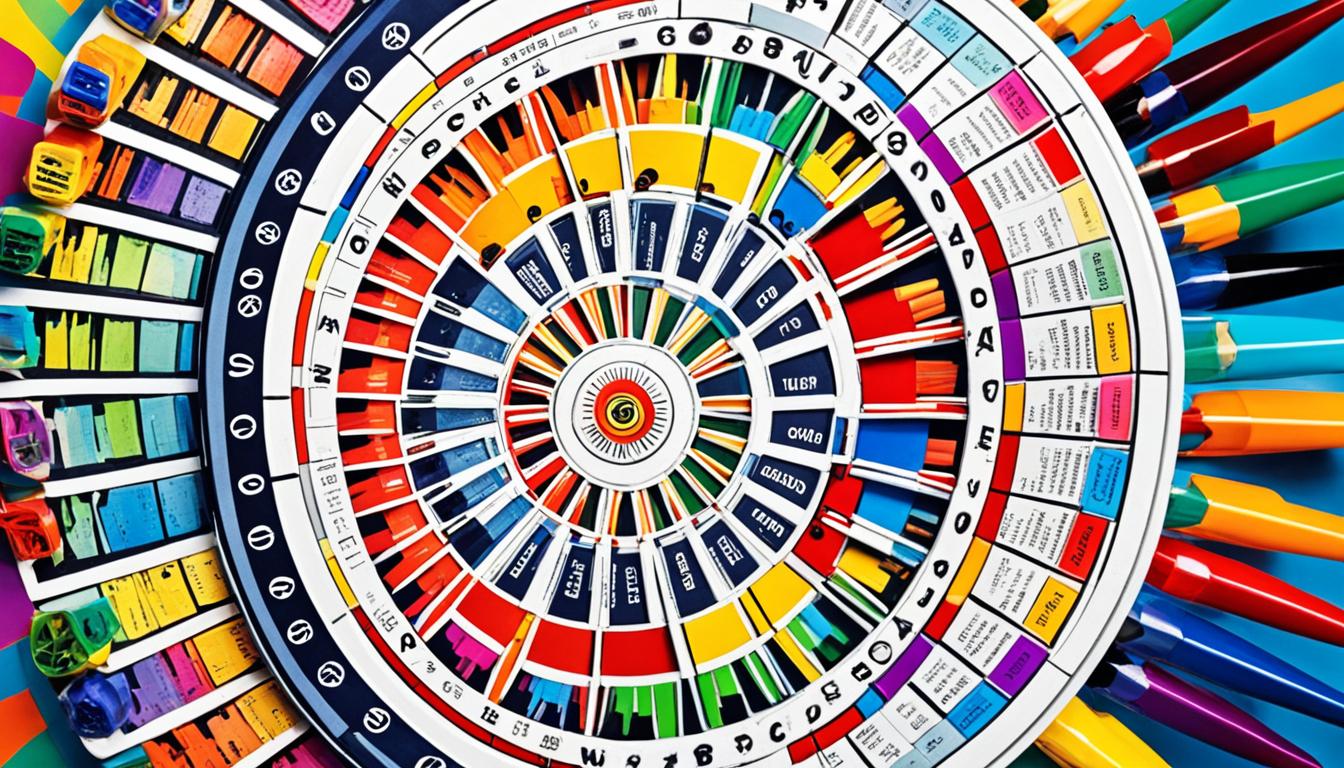
Did you realize that comprehending your personality could enhance your relationships, refine your career options, and foster personal development? Indeed, the distinctive combination of your personality traits significantly influences your identity and your interactions with your surroundings. That’s the rationale behind the importance of taking a personality test for embarking on a journey of self-discovery. And the most exciting part? We’re dedicated to assisting you in discovering your authentic self through our free personality test!
Key Takeaways:
- By taking a personality test, you can gain valuable insights into your individual differences and preferences.
- Your personality traits influence various aspects of your life, including relationships, career choices, and personal development.
- Our free personality test is a scientifically valid and reliable way to discover your unique traits.
- Understanding your personality can help you make informed decisions, improve communication, and develop self-awareness.
- Start your journey of self-discovery today by taking our free personality test!
Understanding the Big Five Personality Traits
The Big Five personality traits, also known as Five Factors or OCEAN, provide a comprehensive framework for understanding individual differences in personality. These traits, which include openness, conscientiousness, extraversion, agreeableness, and neuroticism, influence various aspects of cognition and behavior.
Each of the Big Five traits is measured along a spectrum, allowing individuals to be categorized based on their scores. By assessing where individuals fall on each trait continuum, psychologists can determine their personality type and gain insights into their unique character.
The Big Five model is widely used in personality research due to its scientific validity and reliability. It offers a rich understanding of human behavior and consistently reveals distinct patterns of traits across different populations and cultures.
Let’s explore each of the Big Five personality traits in more detail:
1. Openness
Openness refers to a person’s openness to new ideas, experiences, and intellectual pursuits. Individuals high in openness tend to be imaginative, curious, and willing to embrace novelty. They enjoy exploring new possibilities and are often receptive to unconventional perspectives.
2. Conscientiousness
Conscientiousness reflects a person’s degree of organization, responsibility, and goal-directed behavior. Conscientious individuals are typically detail-oriented, self-disciplined, and diligent in their work. They strive for excellence and are known for their reliability and thoroughness.
3. Extraversion
Extraversion measures how outgoing, assertive, and sociable a person is. Extraverts are energized by social interactions and enjoy being the life of the party. They tend to be talkative, enthusiastic, and seek stimulation from their external environment.
4. Agreeableness
Agreeableness reflects a person’s tendency to be compassionate, cooperative, and accommodating. Individuals high in agreeableness are kind-hearted, nurturing, and enjoy helping others. They prioritize harmonious relationships and often display empathy and understanding.
5. Neuroticism
Neuroticism measures a person’s emotional stability and sensitivity to negative emotions. Individuals high in neuroticism may experience higher levels of anxiety, mood swings, and irritability. They are more prone to stress and may have a heightened emotional reactivity.
Understanding these personality traits can provide valuable insights into an individual’s behaviors, preferences, and interpersonal relationships. By recognizing and appreciating the unique qualities of each personality type, we can foster better communication, enhance collaboration, and cultivate healthier relationships.
| Personality Trait | Description | Low Score | High Score |
|---|---|---|---|
| Openness | Willingness to embrace new ideas and experiences | Practical, traditional | Imaginative, adventurous |
| Conscientiousness | Organization, responsibility, and goal-directed behavior | Spontaneous, careless | Methodical, diligent |
| Extraversion | Outgoing, assertive, and sociable nature | Reserved, solitary | Assertive, outgoing |
| Agreeableness | Compassionate, cooperative, and accommodating nature | Competitive, skeptical | Sympathetic, cooperative |
| Neuroticism | Emotional stability and sensitivity to negative emotions | Emotionally stable, calm | Anxious, moody |
What Does Each Big Five Trait Mean?
In the Big Five personality framework, there are five primary traits that provide insights into individual differences: openness, conscientiousness, extraversion, agreeableness, and neuroticism. Understanding the meanings behind these traits can offer valuable insights into our personalities and how we interact with the world.
Openness
Openness refers to a person’s willingness to embrace new ideas and experiences. Individuals who score high on this trait are imaginative, curious, and open-minded. They enjoy exploring new concepts, cultures, and perspectives, and are often creative and innovative in their thinking.
Conscientiousness
Conscientiousness indicates how goal-oriented and organized a person is. Those who score high on conscientiousness are often reliable, responsible, and diligent. They tend to be meticulous, detail-oriented, and committed to achieving their goals. Conscientious individuals are known for their strong work ethic and ability to stay focused and organized.
Extraversion
Extraversion measures how energized a person is by the outside world. Individuals who score high on extraversion are usually outgoing, sociable, and enthusiastic. They thrive in social settings, enjoy being around others, and often take on leadership roles. Extraverts gain energy from interacting with people and tend to be more talkative and assertive.
Agreeableness
Agreeableness reflects how much a person prioritizes others’ interests over their own. Those who score high on agreeableness are compassionate, empathetic, and cooperative. They value harmonious relationships and are often considered warm, friendly, and understanding. Agreeable individuals are inclined to be considerate of others’ feelings and are skilled at resolving conflicts.
Neuroticism
Neuroticism measures a person’s sensitivity to stress and negative emotions. Individuals who score high on neuroticism are often more prone to anxiety, worry, and mood swings. They may experience intense emotions and be more reactive to stressful situations. People with low neuroticism scores, on the other hand, tend to be more emotionally stable and resilient.
Understanding these five traits helps us better comprehend our own personality and how we relate to others. Each trait exists on a spectrum, and various combinations of these traits contribute to the uniqueness of individuals.

How Heritable Are the Big Five Traits?
Research suggests that certain traits within the Big Five framework have a genetic component. These traits include openness, conscientiousness, extraversion, agreeableness, and neuroticism. Genetic influence plays a significant role in shaping these heritable traits.
“Our genes contribute to our personality traits, providing a foundation upon which our experiences and environment can further shape who we are.”
Let’s take a closer look at the genetic influence of each trait:
Trait Genetic Influence Openness 57% Conscientiousness 49% Extraversion 54% Agreeableness 42% Neuroticism 48%
As seen from the table above, these percentages indicate the extent to which genetics contribute to each trait. However, it’s important to note that genetic influence is not the sole factor in determining personality. Our experiences and environment also play a significant role in shaping who we become.

The Impact of Personality on Longevity
When it comes to living a long and healthy life, our personality traits can play a significant role. Numerous studies have shown that certain personality characteristics, such as conscientiousness, have a positive impact on longevity.
Conscientious individuals tend to lead healthier lifestyles and make safer choices, which can contribute to a longer lifespan. They are more likely to exercise regularly, eat a balanced diet, and prioritize their overall well-being. By taking proactive steps to maintain their health, conscientious individuals reduce their risk of developing chronic illnesses and increase their chances of living a longer, more fulfilling life.
“Conscientious individuals tend to lead healthier lifestyles and make safer choices, which can contribute to a longer lifespan.”
In addition to conscientiousness, traits like agreeableness and optimism have also been linked to better cardiovascular health. People who are agreeable and have a positive outlook on life have lower levels of stress and inflammation, which are known risk factors for heart disease.
Moreover, optimism is associated with resilience and the ability to cope with stress effectively. This mindset can lead to healthier behaviors, such as maintaining social connections, seeking support when needed, and practicing self-care, all of which contribute to improved cardiovascular health and overall well-being.
Health Benefits of Personality Traits:
| Personality Trait | Health Benefit |
|---|---|
| Conscientiousness | Reduced risk of chronic illnesses and longer lifespan |
| Agreeableness | Better cardiovascular health and lower stress levels |
| Optimism | Improved coping mechanisms and reduced risk of heart disease |
While personality plays a role in longevity, it’s essential to acknowledge that it is just one factor among many. Genetic predispositions, environmental factors, socioeconomic status, and access to healthcare also influence our overall health and lifespan. Therefore, it’s crucial to consider a holistic approach and address all aspects of well-being for a balanced and fulfilling life.

Facial Profiling and Personality
At the forefront of personality assessment is Faception, an innovative Israeli startup that is revolutionizing how we understand personality through facial profiling. Using advanced computer vision and facial analysis technology, Faception’s system can determine personality traits based on an individual’s facial features.
This cutting-edge technology is intriguing as it offers the possibility of assessing personality simply by analyzing a person’s facial structure. By leveraging the power of artificial intelligence and machine learning, Faception’s facial profiling technology aims to provide valuable insights into an individual’s personality.
While the concept of facial profiling for personality assessment is fascinating, it’s important to note that the technology is still in its early stages. The methodology and results are not yet widely validated by scientific research or established psychological frameworks.
Nevertheless, the potential implications of facial profiling technology for personality assessment are significant. It opens up new opportunities for understanding individuals on a deeper level and could enhance various areas that require personality insights, such as employment, security, and personal development.

Note: Image portraying the concept of facial profiling for personality assessment.
The Role of Environment in Personality Development
While genetics play a role in determining personality traits, the environment also has a significant impact on personality development. Research has shown that factors such as upbringing and early experiences can shape our personality traits, including openness, conscientiousness, extraversion, agreeableness, and neuroticism.
Our level of openness is influenced by the diversity of cultural influences we experience and how we are raised. Children who grow up in environments that encourage exploration of new ideas and experiences tend to exhibit higher levels of openness as adults.
Conscientiousness is shaped by the expectations and values instilled in us during our upbringing. Growing up in an environment that emphasizes hard work, discipline, and organization can lead to higher levels of conscientiousness in adulthood.
The degree of extraversion we possess can be influenced by the social interactions and experiences we have during our formative years. Those who grow up in sociable and stimulating environments are more likely to develop extraverted traits.
Agreeableness is impacted by the relationships and interactions we have with others. Individuals who are raised in environments that promote empathy, cooperation, and kindness are more likely to exhibit higher levels of agreeableness in their personalities.
Lastly, neuroticism can be influenced by the level of stress and adversity we experience growing up. Individuals who face frequent stressors and challenges during childhood may develop higher levels of neuroticism in adulthood.
Environment plays a crucial role in shaping our personality, interacting with our genetic predispositions to determine who we are. While nature and nurture both contribute to our personalities, it is important to acknowledge that the environment can have a lasting impact on our development.
Personality Within Teams
Personality diversity within teams plays a crucial role in fostering effective collaboration and problem-solving. When individuals with different personality traits and perspectives come together, teams can benefit from a wider range of skills and approaches, leading to innovative outcomes and improved performance.
By harnessing the power of personality diversity, teams can tap into a rich pool of creative ideas and explore various solutions to complex challenges. For example, individuals with high levels of extraversion may excel in networking and initiating new projects, while those with high conscientiousness may bring structure and organization to the team’s workflow.
However, to fully leverage the advantages of personality diversity, it is essential for team members to cultivate an understanding and respect for each other’s personalities. This includes recognizing and valuing the unique strengths and contributions that different personality types bring to the table.
Team dynamics are enhanced when individuals appreciate and harness the complementary nature of their diverse personalities. This can promote a healthy work environment, foster mutual support and collaboration, and empower team members to maximize their potential.
Embracing Personality Diversity
One way to embrace personality diversity within teams is by utilizing personality assessments such as the Big Five personality test. By understanding their own and their teammates’ personality traits, individuals can gain insights into their natural inclinations and communication styles, allowing them to adapt and interact more effectively.
“Embracing personality diversity within teams leads to a broader range of skills, perspectives, and approaches, resulting in increased adaptability and resilience.”, Augustus, Personality Test
By acknowledging and discussing the differences in personality, teams can proactively address potential conflicts and find constructive ways to resolve disagreements. Building a culture of openness and acceptance enables team members to collaborate optimally, leveraging their strengths and working together harmoniously towards shared goals.
The Benefits of Personality Diversity
Personality diversity within teams has numerous benefits:
- Enhanced problem-solving capabilities: Different personality traits can bring diverse problem-solving approaches, leading to more comprehensive and well-rounded solutions.
- Increased creativity and innovation: The combination of different perspectives ignites creativity and promotes innovative thinking, fostering breakthrough ideas.
- Improved communication and collaboration: Understanding and respecting diverse personalities strengthens communication skills and encourages collaboration, enhancing team productivity.
- Adaptability and resilience: Personality diversity equips teams with the flexibility and resilience to navigate challenges and adapt to changing circumstances.
As teams continue to evolve and adapt in today’s dynamic work environment, harnessing the power of personality diversity becomes increasingly essential. By leveraging the unique strengths and perspectives of individuals, teams can unlock their full potential and achieve exceptional results.

Image: Personality diversity within teams leads to effective collaboration and problem-solving.
The Accuracy of Personality Tests
At Truity, we understand the importance of accuracy when it comes to personality tests. That’s why the Big Five personality test, which we offer, has been extensively researched and validated to ensure its validity and reliability.
The Big Five test is built on decades of psychological research and our own rigorous psychometric studies. By comparing an individual’s scores to a large, international sample, we are able to provide accurate insights into their unique personality traits.
However, it’s important to note that personality is complex and can vary across different contexts. While our test provides valuable information, it’s essential to consider other factors and personal experiences that influence one’s behavior and characteristics.
Understanding the accuracy and limitations of personality tests can help you make better-informed decisions about yourself and others. It’s just one piece of the puzzle when it comes to understanding human behavior and should be taken into account along with other relevant information.
The Validity and Reliability of the Big Five Personality Test
The Big Five personality test is known for its high validity and reliability. Validity refers to the extent to which a test accurately measures what it claims to measure, in this case, the five dimensions of personality (openness, conscientiousness, extraversion, agreeableness, and neuroticism).
Reliability, on the other hand, determines the consistency and stability of the test over time. The Big Five test has undergone extensive reliability testing, ensuring consistent results for individuals who take the test multiple times.
Research studies have consistently shown that the Big Five personality test has high validity and reliability. It has been used in various research fields and has proven to be a valuable tool for understanding personality traits and predicting behavior.
When it comes to the accuracy of personality tests, it’s important to consider both their strengths and limitations. While they provide valuable insights, they should be used as a starting point for self-reflection and understanding, rather than an absolute measure of one’s personality.
Ultimately, the accuracy of a personality test depends on various factors, including the quality of the test itself, the interpretation of the results, and the individual’s self-awareness. It’s essential to approach personality testing with an open mind and a willingness to explore and learn more about oneself.

The Benefits of Understanding Your Personality
Understanding your personality can have a profound impact on various aspects of your life. By gaining insights into your unique traits and preferences, you can unlock a range of benefits that contribute to personal growth, self-awareness, and improved decision-making.
Self-Awareness
Self-awareness is a crucial component of personal development. By understanding your personality, you become more aware of your strengths, weaknesses, and areas for growth. This self-awareness allows you to make conscious choices that align with your natural tendencies and goals, leading to greater happiness and fulfillment.
Improved Communication
Knowing your personality can enhance your communication skills. When you understand your own communication style, you can adapt it to better connect with others. This insight helps you navigate conflicts, build more meaningful relationships, and foster collaboration in both personal and professional settings.
Informed Decision-Making
Understanding your personality enables you to make informed decisions. By recognizing your natural inclinations and preferences, you can align your choices with activities that bring you joy and fulfillment. This self-awareness empowers you to pursue careers, hobbies, and relationships that resonate with your inherent strengths and values.
Insights into Relationships
Your personality assessment can provide valuable insights into your relationships. By understanding your communication style, needs, and preferences, you can foster healthier and more harmonious connections with others. Whether in friendships, romantic relationships, or family dynamics, self-awareness allows you to relate to others authentically and navigate conflicts effectively.
Career Alignment
Understanding your personality type can guide you in making career choices that align with your natural inclinations and strengths. By recognizing your preferences in work environments, tasks, and team dynamics, you can pursue careers that offer a fulfilling and rewarding professional journey. This self-knowledge allows you to make informed choices and thrive in your chosen field.
Benefits of Understanding Your Personality Description Self-Awareness Gain deep insights into your strengths, weaknesses, and personal growth opportunities. Improved Communication Enhance your communication skills and build more meaningful relationships. Informed Decision-Making Make choices that align with your natural tendencies and goals. Insights into Relationships Foster healthier and more harmonious connections with others. Career Alignment Pursue careers that match your inherent strengths and preferences.
Overall, a thorough understanding of your personality brings a multitude of benefits, including personal growth, improved relationships, and informed decision-making. Embrace the opportunity to explore your personality traits through assessment and embark on a journey of self-awareness and self-improvement.

Conclusion
To summarize, personality tests like the Big Five test offer valuable insights into our individual differences and can be a powerful tool for self-discovery. By understanding our unique personality traits, we can gain a better understanding of ourselves and navigate the world more effectively.
While genetics play a role in shaping our personalities, environmental factors and personal experiences also have a significant impact. Our upbringing, cultural influences, and life experiences all contribute to who we are and how we interact with the world.
By embracing self-awareness and harnessing the knowledge gained from personality assessments, we can make informed decisions, improve our communication skills, and develop a deeper understanding of our strengths and weaknesses. This self-knowledge can guide our choices in relationships, career paths, and personal growth, ultimately leading to a more fulfilling and successful life.
FAQ
How long does it take to complete the Big Five personality test?
The test consists of 60 questions and takes about 5-10 minutes to complete.
How can I access my test results?
You can access your test results by creating an account on our website.
What are the Big Five personality traits?
The Big Five traits are openness, conscientiousness, extraversion, agreeableness, and neuroticism.
What does the trait “openness” refer to?
Openness refers to a person’s willingness to embrace new ideas and experiences.
What does the trait “conscientiousness” indicate?
Conscientiousness indicates how goal-oriented and organized a person is.
What does the trait “extraversion” measure?
Extraversion measures how energized a person is by the outside world.
What does the trait “agreeableness” reflect?
Agreeableness reflects how much a person prioritizes others’ interests over their own.
What does the trait “neuroticism” measure?
Neuroticism measures a person’s sensitivity to stress and negative emotions.
How heritable are the Big Five traits?
Research suggests that traits within the Big Five framework have a genetic component. For example, openness has a 57% genetic influence, conscientiousness has a 49% genetic influence, extraversion has a 54% genetic influence, agreeableness has a 42% genetic influence, and neuroticism has a 48% genetic influence.
Can personality traits impact longevity?
Yes, certain traits like conscientiousness have been linked to a longer lifespan. People high in conscientiousness tend to lead healthier lifestyles and make safer choices. Additionally, traits like agreeableness and optimism have been associated with better cardiovascular health. However, personality is just one factor among many that influence longevity.
How accurate is facial personality profiling technology?
While facial personality profiling technology is intriguing, it is important to note that it is still in its early stages and not widely validated by scientific research.
How does the environment contribute to personality development?
Research has shown that upbringing and early experiences can shape personality traits. Factors such as how a person is raised and the cultural influences they experience can impact their level of openness, conscientiousness, extraversion, agreeableness, and neuroticism.
How does personality diversity impact teams?
Personality diversity within teams can lead to more effective collaboration and problem-solving. By combining different traits and perspectives, teams can benefit from a wider range of skills and approaches. However, it is important for team members to understand and respect each other’s personalities to avoid conflicts and promote a healthy work environment.
How valid and reliable are personality tests?
The Big Five personality test has been extensively researched to ensure its validity and reliability. It is based on decades of psychological research and Truity’s own psychometric research. The test compares an individual’s scores to a large, international sample, providing insights into their personality traits. However, it is important to remember that personality is complex and can vary across different contexts.
What are the benefits of understanding your personality?
Understanding your personality can help you make informed decisions, improve communication, and develop self-awareness. By knowing your strengths and weaknesses, you can make choices that align with your natural tendencies and goals. Personality assessment can also provide insights into your relationships, career choices, and personal growth.
Emmeline is the backbone of our content creation team, bringing complex psychological concepts to life with clarity and empathy. As our Expert Writer, she crafts engaging, insightful articles that guide readers through the intricacies of personality assessments and what they reveal about the human condition. Her passion for psychology and personal development shines through in every piece she writes.
Self-Understanding
Men Type Quiz: Discover Your Attraction Archetype

Were you aware that getting to know your attraction archetype could offer important clues regarding your personality characteristics and preferences in partners? Indeed it can! The kind of men you find most appealing can uncover intriguing aspects of your personal wishes and requirements in romantic partnerships.
That’s why we’ve created the Men Type Quiz, a fun and enlightening tool that will help you uncover your unique attraction archetype. By answering just 20 simple questions, you’ll gain a deeper understanding of the kind of men who captivate your heart and ignite your passion.
Curious to discover your attraction archetype and what it says about your preferences? Let’s dive in!
Key Takeaways:
- Understanding your attraction archetype can provide valuable insights into your personality traits and preferences in relationships.
- The Men Type Quiz helps you uncover the type of men you are most attracted to through 20 simple questions.
- Your attraction archetype can shed light on patterns in your attractions and help you make more informed choices in love.
- Research suggests that individuals tend to seek partners with similar personalities to their exes, indicating the presence of attraction types.
- Attraction involves complex processes in the brain, including the release of chemicals and physical signs of interest.
The King: Dominance and Independence
The King archetype represents dominant and independent men who play a central role in their environment. These men possess qualities that command attention and inspire respect. They exude confidence and strive for higher spiritual and physical heights. The King is a figure of authority and leadership, projecting an air of power and control.

However, it is important to note that the King archetype’s dominance can sometimes manifest as unfaithfulness and tyranny. Their strong desire for control and independence can lead to challenges in establishing and maintaining healthy relationships.
Understanding the King archetype can help individuals identify if they are attracted to strong figures who possess qualities of dominance and independence. It serves as a reminder to navigate these attractions with mindfulness, considering the potential impact of such powerful personalities on their lives.
The King Archetype at a Glance
- Dominant and independent
- Striving for higher spiritual and physical heights
- A figure of authority and leadership
- Possibly exhibiting traits of unfaithfulness and tyranny
It is important to approach relationships with a balanced perspective and to ensure that both partners’ needs are met. By recognizing the influence of the King archetype, individuals can better navigate their attractions and forge healthy and fulfilling connections.
“The King archetype embodies the essence of dominance and independence. While their commanding presence can be alluring, it’s crucial to evaluate the overall dynamics and ensure a healthy balance in relationships.” – Relationship Expert
The Warrior: Bravery and Passion
The Warrior archetype represents brave and passionate men who embody qualities of strength and determination. These men not only take care of their physical appearance but also prioritize their health and well-being. They understand the importance of maintaining a fit and strong physique, which often makes them attractive to others.
The Warrior archetype is characterized by bravery and a fierce passion for life. These men are not afraid to take risks and pursue their dreams with unwavering determination. Their adventurous spirit is contagious and can inspire those around them.
“A true Warrior is not afraid of failure; they see it as an opportunity to learn and grow.”
Regarding relationships, the Warrior archetype is known for being supportive and loyal partners. They are willing to go the extra mile to protect and defend their loved ones. Their bravery extends beyond physical courage; they are also courageous in expressing their emotions and vulnerabilities.
“Real strength lies in vulnerability. The Warrior understands the power of opening their heart and embracing their emotions.”
However, it’s important to note that the competitive nature of the Warrior archetype can present challenges. Their drive to be the best and excel in all areas of life may sometimes overshadow their ability to prioritize their relationships. Additionally, their passion can sometimes lack direction, leading to indecisiveness or focus.
“The Warrior seeks purpose, but may need guidance to find their true path.”
Recognizing the Warrior archetype within yourself can help you understand your attraction to athletic and adventurous men. If you find yourself drawn to individuals who embody bravery, passion, and a drive for excellence, you may have an innate attraction to Warriors.
Benefits of being attracted to Warriors:
- Enjoy an active and adventurous lifestyle
- Experience unwavering support and loyalty
- Share a passion for personal growth and self-improvement
- Engage in exciting and daring experiences
Challenges of being attracted to Warriors:
- Competitiveness and the need to always be the best
- Lack of direction or focus in certain areas of life
- Balancing their strong sense of independence with the need for emotional connection
The Warrior archetype represents an appealing and captivating type of man, characterized by bravery, passion, and a commitment to personal growth. Recognizing your attraction to athletic and adventurous individuals with a Warrior mindset can help you find a partner who shares your values and complements your own journey towards self-realization.

The Magician: Knowledge and Sophistication
Regarding attraction, there is something undeniably intriguing about men who possess knowledge and sophistication. Enter the Magician archetype, a symbol of intellectual prowess and mental strength. These men have a unique charm that captivates us, drawing us in with their wit and depth of understanding.
Unlike other archetypes, the Magician tends to be more detached from their emotions. While they may not wear their heart on their sleeve, their analytical and rational approach to situations often translates into a sense of stability and composure. Their preference for planning and foresight ensures that they carefully consider life.
For those who find themselves irresistibly attracted to intellectuals and thoughtful individuals, the Magician archetype holds a special allure. These men embody a refined sense of sophistication that is both captivating and inspiring. Whether it’s engaging in deep conversations or exploring the intricacies of their interests, being in the company of a Magician can be a truly enriching experience.
The Charismatic Intellect
One of the defining traits of the Magician archetype is their thirst for knowledge. They are drawn to expanding their understanding of the world and constantly seeking answers to life’s questions. This insatiable curiosity often translates into captivating conversations filled with intellectual depth.
Furthermore, the Magician’s disciplined nature enables them to approach challenges with a level-headedness that is both reassuring and attractive. Their ability to analyze situations and provide thoughtful insights can leave a lasting impression on those around them.
However, it is important to note that the Magician’s predisposition for rationalization and detachment can sometimes create a barrier when it comes to emotional connection. While they may excel in intellectual pursuits, expressing and understanding emotions may require more effort on their part.
The Appeal of Sophistication
The Magician archetype exudes an air of sophistication that is hard to resist. Their refined tastes, elegant style, and ability to appreciate the finer things in life can be incredibly alluring.
Whether it’s indulging in stimulating cultural experiences or savoring the complexities of art, literature, or music, the Magician is often attracted to intellectual pursuits and aesthetic beauty. This appreciation for sophistication extends to their choice of partners, as they seek individuals who can match their level of intellectual curiosity and appreciation for the arts.

This image perfectly encapsulates the essence of the Magician archetype with its portrayal of a man immersed in his books, surrounded by knowledge. It serves as a visual representation of the allure and attraction that intellectual men possess.
ATTRIBUTES DESCRIPTION Intellectual Curiosity A deep longing for knowledge and a desire to explore the world of ideas and concepts. Rational Thinking An analytical approach to situations, preferring logic and reason to guide their decisions. Sophisticated Taste An appreciation for the finer things in life, such as art, literature, and cultural experiences. Emotional Detachment A tendency to rationalize emotions and prioritize logical thinking over emotional expression. Discipline and Planning A structured approach to life, preferring to plan and prepare for various outcomes.
Understanding your attraction to the Magician archetype can provide valuable insights into your preferences when it comes to finding a partner. By recognizing the allure of knowledge and sophistication, you can better navigate your own desires and forge connections that align with your intellectual and emotional needs.
The Lover: Passion and Sensuality
The Lover archetype embodies the essence of passionate love and sensuality. These men are fully present in the moment, embracing the beauty and pleasure of life. They have a deep appreciation for various forms of art and find inspiration in their surroundings. The allure of an artistic man lies in his ability to tap into his emotions and express himself creatively.
When in a relationship, a Lover can be a fun and energetic partner, infusing excitement and romance into every moment. Their passion can be intoxicating, igniting a fire within you. However, it’s important to note that Lovers may struggle with commitment and have addictive tendencies.
Recognizing the Lover archetype can help you understand if you are attracted to artistic and passionate men. If you find yourself drawn to individuals who share this archetype, you may thrive in relationships filled with vibrant energy, deep connections, and sensual experiences.
“Passion is the oxygen of the lover’s soul. It fuels their creative spirit and intensifies their desire for connection.”
The Charms of an Artistic Man
Artistic men possess a unique allure that can captivate your heart and mind. Here are some qualities that make them irresistible:
- Creativity: Artists have a boundless imagination that brings vibrancy and originality to their lives. They approach the world with an open mind, constantly seeking inspiration and finding beauty in unexpected places.
- Expressiveness: Artistic men have a natural ability to express their emotions, whether through words, music, or visual art. They wear their hearts on their sleeves, allowing you to experience a profound depth of feeling in their presence.
- Sensuality: Artists have a heightened awareness of the senses, making them skilled at creating sensual experiences. Whether it’s a candlelit dinner, a passionate dance, or a heartfelt love letter, they know how to awaken your senses and indulge in pleasure.
- Intuition: Artistic men possess a keen intuition that enables them to understand and connect with others on a deep level. They have an innate ability to recognize and appreciate the subtleties of human emotions, making them empathetic and nurturing partners.
These qualities add depth and richness to the relationship, creating a dynamic and fulfilling connection that transcends the ordinary.

| Pros of Being with an Artistic Man | Cons of Being with an Artistic Man |
|---|---|
|
|
While being with an artistic man can be an exhilarating and transformative experience, it is essential to navigate the complexities that come with their passionate nature. Communication, understanding, and embracing the unique qualities they bring to the table are vital for a harmonious and fulfilling relationship.
Understanding Your Attraction Archetype
Discovering your attraction archetype through this quiz can provide valuable insights into your personality traits and preferences in relationships. Understanding your archetype can help you identify patterns in your attractions and make informed choices in your love life. It can also shed light on potential compatibility issues with different types of men.
By delving into your attraction archetype, you gain a deeper understanding of your own desires and needs. This knowledge empowers you to navigate the complexities of relationships with greater self-awareness and purpose. It allows you to recognize the personality traits that resonate with you and explore the compatibility of different attraction archetypes.
Different attraction archetypes often exhibit distinct personality traits that can affect the dynamics of a relationship. For example, if you have a preference for the Warrior archetype, you may be drawn to brave and passionate individuals who value physical fitness and adventure. On the other hand, if you resonate with the Magician archetype, you may find yourself attracted to intellectual and knowledgeable partners who prioritize personal growth and wisdom.
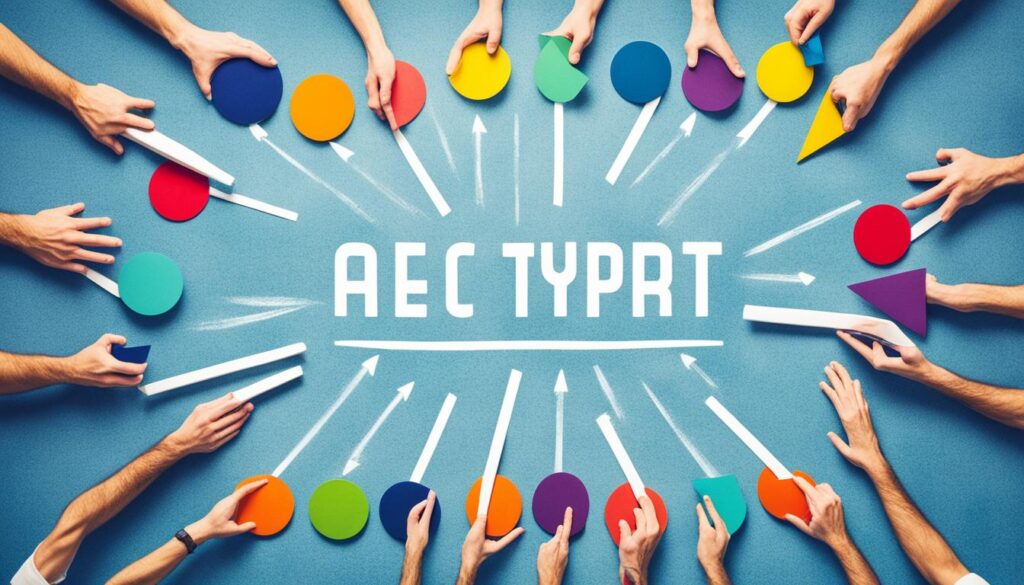
As you explore your attraction archetype, it’s important to remember that compatibility is not solely determined by archetype type. While certain archetypes may naturally complement each other, factors such as individual values, goals, and communication styles also play a significant role in relationship success.
Table:
Attraction Archetype Personality Traits Compatibility Relationship Preferences The King Dominance, Independence Seeking equals or partners who appreciate leadership qualities Prefer a balance of power and freedom in a relationship The Warrior Bravery, Passion Compatible with individuals who value adventure and physical fitness Thrives in relationships with emotional support and loyalty The Magician Knowledge, Sophistication Drawn to intellectual individuals with a passion for personal growth Seeks stimulating conversations and intellectual pursuits The Lover Passion, Sensuality Attracted to creative and artistic individuals who embrace passion Values freedom and spontaneity in relationships
Understanding your attraction archetype helps you navigate the dating landscape with clarity and purpose. It enables you to recognize your unique preferences and align them with potential partners who share similar values and relationship preferences.
Do Personalities Influence Attraction?
Research shows that when it comes to attraction, personalities play a significant role. People often find themselves seeking partners with similar personalities to their exes, suggesting the existence of specific attraction types based on individual character traits.
While some individuals may have a specific attraction type, there are exceptions. Those who possess extraverted and open-minded qualities tend to be more flexible and open to diverse partner preferences.
“It’s fascinating how our personalities shape our attraction preferences. Finding similarities in past partners might indicate a subconscious inclination towards certain personality traits,” says Dr. Samantha Miller, a renowned psychologist.
This phenomenon highlights the significance of understanding our own personalities and how they influence our attraction choices. By recognizing our attraction types, we can gain insights into what traits and qualities we are naturally drawn to in potential partners.
Furthermore, this understanding can help us identify patterns in our attractions and make more informed decisions in our love lives. It allows us to pinpoint the compatibility between our personalities and those of potential partners, increasing our chances of building fulfilling and long-lasting relationships.
It’s important to note that while personalities influence attraction, they are just one factor among many. Biology, shared interests, and individual experiences also play significant roles in shaping our preferences.
The Role of Compatibility
Compatibility is key in any relationship. When seeking a partner, it’s natural to desire someone who possesses similar traits and values. Shared personalities often contribute to a sense of understanding and harmony within a relationship.
By seeking partners with similar personalities, individuals aim to create a connection based on familiarity and common ground. This can lead to greater compatibility and increased relationship satisfaction.
However, it’s crucial to strike a balance. Too much similarity can result in a lack of growth and diversity within a relationship. It’s important to also embrace differences and appreciate the unique qualities that each partner brings to the table.
The Science of Attraction
Attraction is a fascinating phenomenon that involves complex processes in the brain. When we experience attraction, our brains release chemicals associated with the reward center, creating feelings of giddiness and euphoria. This chemical response contributes to the intense emotions and excitement we feel when we are attracted to someone.
On the other hand, lust is primarily driven by sexual gratification and the release of sex hormones. It is a more primal and instinctive desire rooted in our biology. Lust can be characterized by a strong physical attraction and a heightened desire for sexual intimacy.
In addition to these internal processes, external factors also play a role in attraction. Pheromones, subtle scents emitted by individuals, can influence our attraction to them. These chemical signals can subconsciously impact our perception of a person’s attractiveness and compatibility.
Furthermore, there are various physical signs that can indicate attraction. Eye contact, for example, plays a significant role in nonverbal communication and can be a strong indicator of interest and attraction. Proximity is another physical sign that suggests a potential attraction, as people tend to move closer to someone they are attracted to.

Understanding the science of attraction can provide valuable insights into the intricacies of human interaction and the drivers behind our desires. By being aware of the biological and psychological processes at play, we can navigate our own attractions with a greater understanding and make more informed choices in our relationships.
Conclusion
Taking the men type quiz and understanding your attraction archetype can provide valuable insights into your preferences and patterns in attraction. It’s important to remember that attraction is a complex interplay of personality, biology, and individual experiences.
By being aware of your attraction type, you can make more informed choices in relationships. You will have a better understanding of your own desires and needs, and you can seek partners who align with your preferences. This knowledge can contribute to healthier and more fulfilling connections.
So, take the men type quiz today and discover your attraction archetype. Uncover the mysteries of your preferences and gain a deeper understanding of yourself. Armed with this knowledge, you can navigate the dating world with confidence and better align your choices with your true desires.
INTJ personalities thrive in structured environments where their strategic thinking flourishes. Understanding one’s attraction archetype can direct INTJs toward highpaying careers for intjs that satisfy both their intellectual rigor and their desire for autonomy. Such insight shapes career paths aligned with their innate preferences and exceptional foresight. The Men Type Quiz is a quiz designed for women to understand their attraction archetype. It helps you uncover the type of man you are most attracted to by answering 20 simple questions.
The four common personality archetypes are the King, the Warrior, the Magician, and the Lover.
The King archetype represents dominant and independent men who play a central role in their environment.
The Warrior archetype embodies brave and passionate men who care about their looks and health.
The Magician archetype represents men of knowledge and sophistication who are disciplined and mentally strong. The Lover archetype is associated with passionate love and sensual pleasure, and men of this archetype are fully present in the moment and enjoy various forms of art.
Understanding your attraction archetype can provide valuable insights into your personality traits and preferences in relationships.
Yes, your attraction archetype can shed light on potential compatibility issues with different types of men.
Research suggests that people tend to seek out partners with similar personalities to their exes, indicating that individuals have a specific attraction type based on their own character traits.
Attraction involves complex processes in the brain, including chemical releases and physical signs like eye contact and proximity. Lust is primarily driven by sexual gratification and hormones, while pheromones can also influence attraction. Taking the Men Type Quiz and understanding your attraction archetype can help you make more informed choices in relationships and enhance your understanding of your own desires and needs.
How Can My Attraction Archetype Influence My Career Choices as an INTJ?
FAQ
What is the Men Type Quiz?
What are the four common personality archetypes?
What does the King archetype represent?
What does the Warrior archetype represent?
What does the Magician archetype represent?
What does the Lover archetype represent?
What can I learn by understanding my attraction archetype?
Can my attraction archetype affect relationship compatibility?
Do personalities influence attraction?
What factors contribute to attraction?
How can the Men Type Quiz help me?
Eugene brings a fresh, dynamic voice to our platform as one of our talented Writers. Specializing in research-driven content, he explores the latest findings in psychology and personal growth, translating them into actionable insights for our readers. Eugene’s work is fueled by a curiosity about what makes us tick and a desire to help others unlock their potential.
-

 Relationship Dynamics3 months ago
Relationship Dynamics3 months agoCan a Man Truly Love His Side Chick
-

 Enneagram of Personality1 week ago
Enneagram of Personality1 week agoEnneagram Test: Printable Version for Easy Self-Discovery
-

 Personality Exploration3 weeks ago
Personality Exploration3 weeks agoDiscover Your Traits with Atomic Habits Personality Test
-

 Personality Exploration3 months ago
Personality Exploration3 months agoDOPE Personality Test Explained: Traits & Types
-
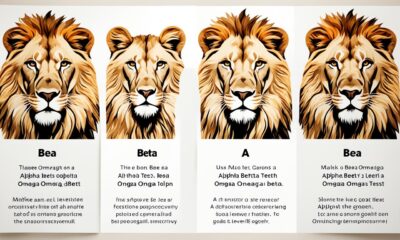
 Personality Exploration3 weeks ago
Personality Exploration3 weeks agoAlpha Beta Omega Personality Test Explained
-

 Personality Exploration3 months ago
Personality Exploration3 months agoAlpha Beta Omega Sigma Female Personality Quiz
-

 Self-Understanding2 months ago
Self-Understanding2 months agoDiscover Your Traits with Our Personality Test
-

 Personality Exploration3 months ago
Personality Exploration3 months agoUnderstanding Personality Tests | Our Guide Explained
